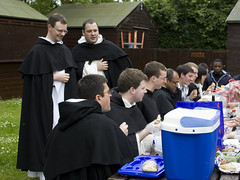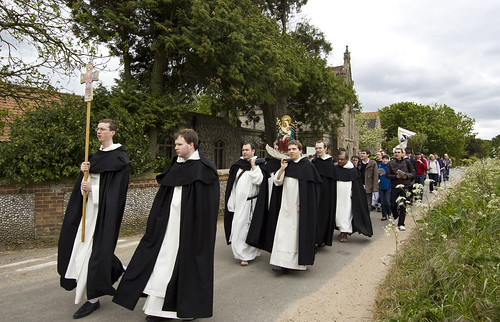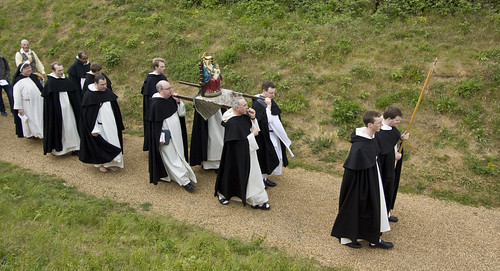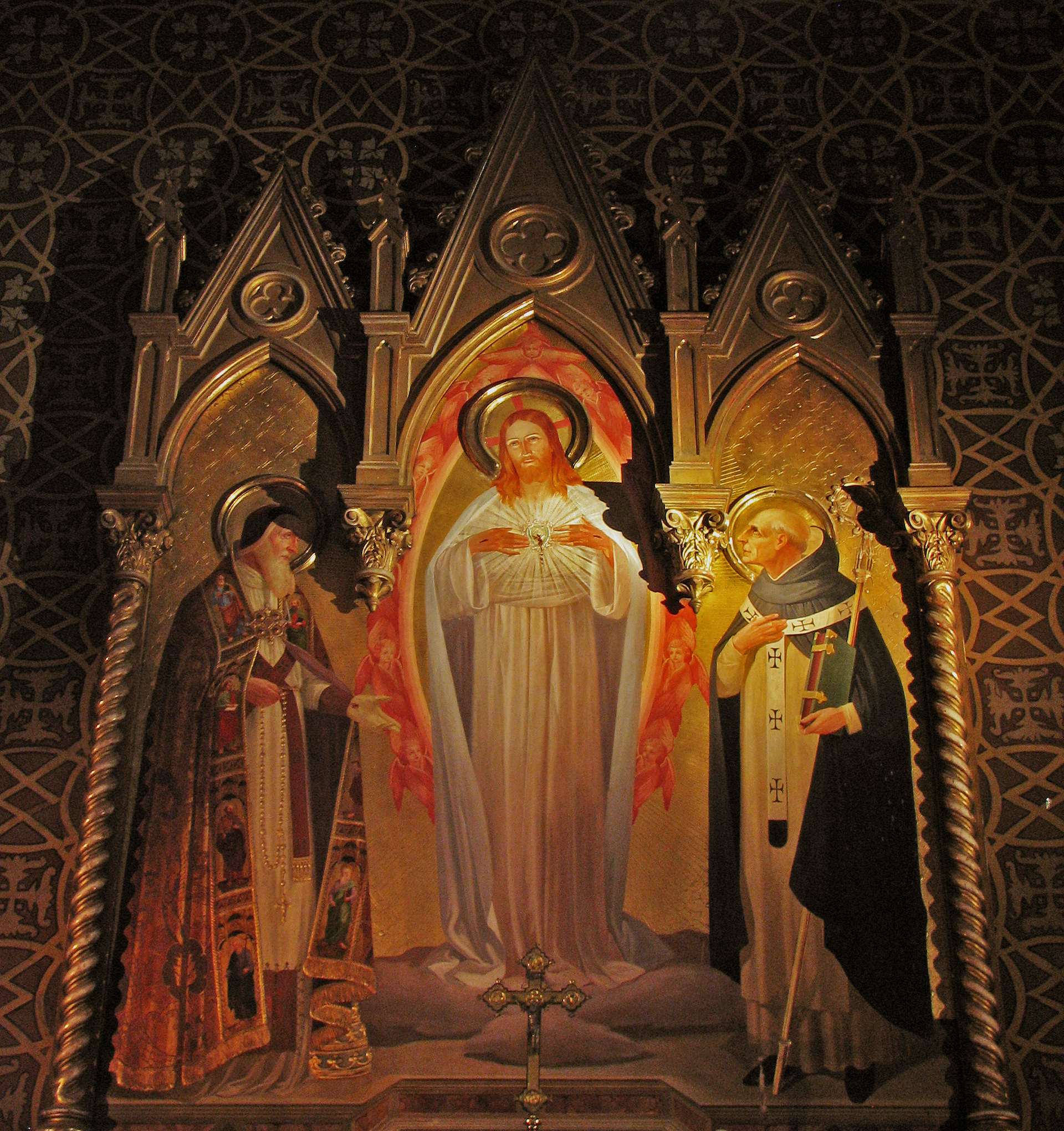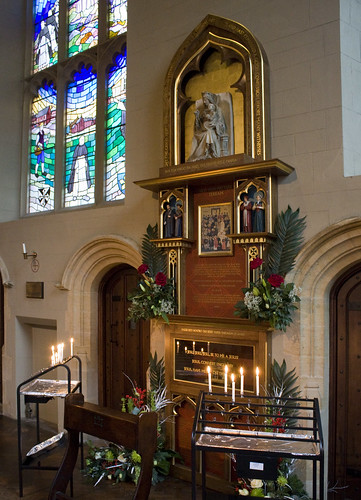Please join with us in praying for the eternal repose of our brother Columba Rabbett OP who died on 3rd May 2011. Here is the homily preached at his funeral by fr Colin Carr OP. The readings were Wisdom 3:1-9, Romans 6:3-8, and John 14:2-7. |
| St Martin de Porres OP |
Dominicans tend not to be like each other. But you may wander into the funeral of Dominican A and hear things said about him which sound rather like Dominican B. But in the case of Columba, or William or Billy as many of you called him, you couldn't mistake him for any other Dominican, or any othe human being, for that matter.
Let's be contrary in this Dominican funeral and quote a poet who was also a Jesuit, Gerard Manley Hopkins: you don't so much understand his poems as get a sense of the wonder and uniqueness of all creatures; in one, called "Kingfishers catch Fire" he writes:
Each mortal thing does one thing and the same:
Deals out that being indoors each one dwells;
Selves – goes itself; myself it speaks and spells,
Crying 'What I do is me; for that I came'.
Acts in God's eyes what in God's eyes he is -
Christ – for Christ plays in ten thousand places,
Lovely in limbs, and lovely in eyes not his
To the Father through the features of men's faces.
It's our calling to be unique, to show Christ in the way only we can, to be the self only we can be. But that unique self is not just a passing piece of history. Our first reading showed a Jewish writer struggling towards a sense of an after- life, a life with God which is not quenched by death. Up till that time Jews had very properly been concerned to make sure people had a good life before death, but gradually they came to confront that niggling question which human beings ask themselves: is that all? And they were sure that the creative, life-giving God of their belief must welcome the dead into something better than extinction. Many people still have only a question mark around the possibility of eternal life; for many such, Columba – usually in the person of William – gave a hint, a rumour, that there is more to life than meets the eye. This was surely because he saw Christ in ten thousand places so that he could walk down a dangerous street in a Caribbean town and be completely safe because the "dangerous" people knew he didn't despise them.
 |
| Derry, Columba's birthplace |
The Caribbean – two years in Grenada and five in Barbados – was one of his assignations as a Dominican. Having come over from Derry to work on the railways in London in his late teens – and I'm afraid there is nothing miraculous or scurrilous to report in his childhood, quite a portion of which was spent in the care of Granny Rabbett – he became a novice at Hawkesyard, and, in 1953, aged 21, was simply professed. It was another Columba who gave William his own religious name while he was Master of Novices; Columba Ryan himself died only recently, in August 2009; he was another unrepeatable character, and he and our Columba lived together again, in Glasgow, from 1967 to 1969.
Before and after that period he spent time in the Oxford and London Priories, doing things which Lay Brothers were expected to do, cooking, cleaning, sacristy work, counting the collections, answering the door, making beds for guests – in general making a Priory a home. He also spent an amount of time doing things which Lay Brothers were not supposed to do, like drinking uproariously in local pubs and coming home 'worse for the wear'. He would not want us to paint a picture of himself which did not include that aspect. Conviviality was part of his life, and he didn't always avoid the attendant dangers of it. But he was a homemaker both for his brethren and for guests, like two law students from Newcastle, Michael Joyce and Paddy Cosgrove, who found in the London Priory a special kind of home from home.
And much earlier he encouraged at least one young lad who became an altar-server and later helper around the house in London and finally decided to join the Dominicans the year I joined: Malcolm McMahon who went on to become our Provincial and then Bishop of Nottingham and who is with us today. Perhaps that home-making instinct was what made Columba choose the Gospel we have just read, in which Jesus is heard speaking of the home he is preparing for us in the Father's spacious house.
 |
| St George's, Grenada |
Before he came to us he spent 7 years in the Caribbean, first in Grenada and then what seem to have been mainly very happy years in Barbados as a close personal assistant to Bishop Dixon for whom he clearly had great respect. He took on not just domestic tasks but considerable ecclesiastical responsibilities such as dealing with marriage cases. But his relationship with ordinary people was what was most important, both to him and to Bishop Dixon who really took seriously the priestly vocation of all God's people.
And so to Newcastle in 1996. If I didn't know I'd have said he'd been here longer than that, because as usual he managed to cram a lifetime into those 15 years. Our then Provincial, now Bishop Malcolm, begged us to take him because he couldn't think of anywhere else to place him; he was seen as some kind of a problem. I just wish all my problems were Columba-shaped.
As usual he buckled down to cooking, cleaning, sacristy work, befriending local people, giving everyone nicknames – I'm not too sure if I want to find out what mine was. Monday was his day off, but before he went out he had put in what most of us would consider a day's work. He loved chopping vegetables for his home-made soup, and would buy more food than we needed on the grounds that you never knew who might turn up and need feeding. He was known to parishioners and to many who would never normally come to church; he was a voice for the gospel way beyond the confines of those who know what "Gospel" means; but they would hear good news about their not being judged and condemned from this one representative of the church whom they knew. Persecution and straight opposition never silenced the church, but respectability has silenced it in the ears of many people, and William made sure that a voice was heard where there had been silence.
As he learned of the nature of his illness he set about the business of dying with characteristic vigour. He specified what kind of a funeral service he would have, and while we haven't been able to cross all the t's and dot all the i's we are doing our best. He was a massively forthright and energetic person, one who would not suffer fools gladly, but what people noticed about him latterly was a gentleness and almost an innocence, which goes to show that innocence is not something you have once and then lose, but something into which you grow.
 |
| Newcastle, where Columba spent the last years of his life |
Leo and I could not have dealt with the necessary caring without the help of the two Johns – it gets dangerous to start mentioning names, because many others, men and women were supportive too. The last woman parishioner to visit him, on the Sunday night, was struck by his gentleness and what she described as an angelic look or the look of a young lad: his skin had quite suddenly become much smoother, and what with his brand new white dressing gown he looked the part. When she asked him if he was afraid to die he said he was just sorry for all the people he had hurt; there are plenty of people whom he deeply affirmed who would speak up for him. He knew the end was near when he summoned me back to the hospital after 11.00pm on Monday night, wishing to make his peace with God; he had already been anointed, but that night he received absolution and communion. Not more than 3 hours later he was dead. The death he had died in Baptism 79 years previously helped him to discover in his own death the gateway to life.
Eternal rest grant to our brother Columba, Lord, and let perpetual light shine upon him.
May he rest in peace. Amen.
 In the Byzantine tradition, it is the custom to put out an icon of the feast of the day in the middle of the church, depicting the saint or the event being celebrated. So it is interesting to see what image is used in this tradition for Easter Day (and indeed on all Sundays throughout the year) when Christ’s Resurrection is the particular focus of our celebration. The icon is entitled ‘The Resurrection’, sometimes even ‘The Resurrection of Our Lord Jesus Christ’, but what we see is not a scene at the tomb in the garden where the body of Jesus had been laid. It is possible, as we see in the West, to depict the risen Christ, the result of that moment of Resurrection, but the event itself, not witnessed by any human eye, is considered impossible to depict.
In the Byzantine tradition, it is the custom to put out an icon of the feast of the day in the middle of the church, depicting the saint or the event being celebrated. So it is interesting to see what image is used in this tradition for Easter Day (and indeed on all Sundays throughout the year) when Christ’s Resurrection is the particular focus of our celebration. The icon is entitled ‘The Resurrection’, sometimes even ‘The Resurrection of Our Lord Jesus Christ’, but what we see is not a scene at the tomb in the garden where the body of Jesus had been laid. It is possible, as we see in the West, to depict the risen Christ, the result of that moment of Resurrection, but the event itself, not witnessed by any human eye, is considered impossible to depict.









